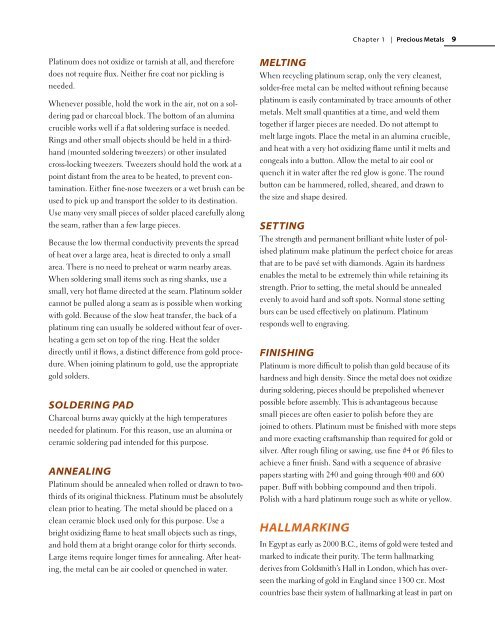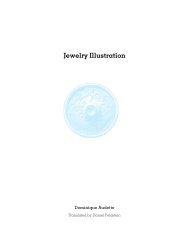Professional Jewelry Making - Brynmorgen Press
Professional Jewelry Making - Brynmorgen Press
Professional Jewelry Making - Brynmorgen Press
Create successful ePaper yourself
Turn your PDF publications into a flip-book with our unique Google optimized e-Paper software.
Platinum does not oxidize or tarnish at all, and therefore<br />
does not require flux. Neither fire coat nor pickling is<br />
needed.<br />
Whenever possible, hold the work in the air, not on a soldering<br />
pad or charcoal block. The bottom of an alumina<br />
crucible works well if a flat soldering surface is needed.<br />
Rings and other small objects should be held in a thirdhand<br />
(mounted soldering tweezers) or other insulated<br />
cross-locking tweezers. Tweezers should hold the work at a<br />
point distant from the area to be heated, to prevent contamination.<br />
Either fine-nose tweezers or a wet brush can be<br />
used to pick up and transport the solder to its destination.<br />
Use many very small pieces of solder placed carefully along<br />
the seam, rather than a few large pieces.<br />
Because the low thermal conductivity prevents the spread<br />
of heat over a large area, heat is directed to only a small<br />
area. There is no need to preheat or warm nearby areas.<br />
When soldering small items such as ring shanks, use a<br />
small, very hot flame directed at the seam. Platinum solder<br />
cannot be pulled along a seam as is possible when working<br />
with gold. Because of the slow heat transfer, the back of a<br />
platinum ring can usually be soldered without fear of overheating<br />
a gem set on top of the ring. Heat the solder<br />
directly until it flows, a distinct difference from gold procedure.<br />
When joining platinum to gold, use the appropriate<br />
gold solders.<br />
solderIng PAd<br />
Charcoal burns away quickly at the high temperatures<br />
needed for platinum. For this reason, use an alumina or<br />
ceramic soldering pad intended for this purpose.<br />
AnneAlIng<br />
Platinum should be annealed when rolled or drawn to twothirds<br />
of its original thickness. Platinum must be absolutely<br />
clean prior to heating. The metal should be placed on a<br />
clean ceramic block used only for this purpose. Use a<br />
bright oxidizing flame to heat small objects such as rings,<br />
and hold them at a bright orange color for thirty seconds.<br />
Large items require longer times for annealing. After heating,<br />
the metal can be air cooled or quenched in water.<br />
meltIng<br />
When recycling platinum scrap, only the very cleanest,<br />
solder-free metal can be melted without refining because<br />
platinum is easily contaminated by trace amounts of other<br />
metals. Melt small quantities at a time, and weld them<br />
together if larger pieces are needed. Do not attempt to<br />
melt large ingots. Place the metal in an alumina crucible,<br />
and heat with a very hot oxidizing flame until it melts and<br />
congeals into a button. Allow the metal to air cool or<br />
quench it in water after the red glow is gone. The round<br />
button can be hammered, rolled, sheared, and drawn to<br />
the size and shape desired.<br />
settIng<br />
The strength and permanent brilliant white luster of polished<br />
platinum make platinum the perfect choice for areas<br />
that are to be pavé set with diamonds. Again its hardness<br />
enables the metal to be extremely thin while retaining its<br />
strength. Prior to setting, the metal should be annealed<br />
evenly to avoid hard and soft spots. Normal stone setting<br />
burs can be used effectively on platinum. Platinum<br />
responds well to engraving.<br />
fInIsHIng<br />
Platinum is more difficult to polish than gold because of its<br />
hardness and high density. Since the metal does not oxidize<br />
during soldering, pieces should be prepolished whenever<br />
possible before assembly. This is advantageous because<br />
small pieces are often easier to polish before they are<br />
joined to others. Platinum must be finished with more steps<br />
and more exacting craftsmanship than required for gold or<br />
silver. After rough filing or sawing, use fine #4 or #6 files to<br />
achieve a finer finish. Sand with a sequence of abrasive<br />
papers starting with 240 and going through 400 and 600<br />
paper. Buff with bobbing compound and then tripoli.<br />
Polish with a hard platinum rouge such as white or yellow.<br />
HAllmArkIng<br />
chapter 1 | Precious Metals 9<br />
In Egypt as early as 2000 B.C., items of gold were tested and<br />
marked to indicate their purity. The term hallmarking<br />
derives from Goldsmith’s Hall in London, which has overseen<br />
the marking of gold in England since 1300 ce. Most<br />
countries base their system of hallmarking at least in part on




